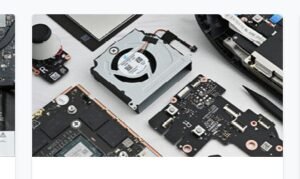repair any electronic Welcome to our comprehensive guide on how to repair any electronic instrument! In today’s fast-paced world, our lives are increasingly intertwined with technology. From smartphones and laptops to gaming consoles and music players, electronic devices have become an essential part of our daily routines. But what happens when these beloved gadgets break down? Panic sets in, frustration rises, and the question arises: “How can I fix this?” Well, fear not! In this blog post, we will explore the common problems faced by electronic instruments and provide you with practical solutions to get them back up and running in no time. So grab your toolkit and let’s dive into the wonderful world of electronics repair!

Why do electronics break?
Why do electronics break? It’s a question that often lingers in our minds when faced with malfunctioning devices. Well, there are several factors at play here.
One of the main reasons is simply wear and tear. Just like any other object we use daily, electronic instruments undergo regular usage which can lead to their eventual breakdown. Components may become worn out or damaged over time, resulting in diminished performance or complete failure.
Accidents happen. We’ve all experienced that heart-stopping moment when an electronic device slips from our hands and crashes onto the ground. Physical damage can cause internal components to shift or break, rendering the instrument non-functional.
Improper handling and maintenance can contribute to electronic failures. Neglecting routine upkeep such as cleaning dust accumulation or ignoring warning signs of potential issues only exacerbates the problem.
Let’s not forget about technology advances. As newer models and versions are released with improved features and capabilities, older electronic instruments may struggle to keep up with these advancements leading them towards obsolescence.
Understanding why electronics break is crucial for effectively addressing their issues and finding suitable solutions. Now that we have explored this aspect let us move on to discussing some common problems encountered in these gadgets!
What are the most common problems?
One of the most frustrating things about electronic instruments is when they stop working properly. Whether it’s a smartphone, tablet, laptop, or other device, there are common problems that can arise. Here are some of the most common issues you may encounter with your electronic instrument.
First and foremost, a broken screen is a frequent problem that many people face. Accidental drops or impacts can result in cracked or shattered screens, making it difficult to use the device effectively. Thankfully, fixing a broken screen often involves replacing the display panel, which can be done by professionals or even by yourself if you’re handy.
Another common issue is audio problems. This could manifest as distorted sound quality, no sound at all, or issues with headphone jacks and speakers. Troubleshooting audio problems may involve checking volume settings, updating drivers or software patches if available, and possibly replacing faulty hardware components.
Non-responsive buttons are another annoyance that many people encounter with their electronic devices. This could be due to debris getting stuck under the buttons or worn-out contacts within them. In such cases, gently cleaning around the buttons might solve the problem; otherwise replacing individual buttons might be necessary.
Software issues are also quite prevalent in today’s digital age. These include freezing screens,
slow performance,
and unresponsive operating systems
that make using your device nearly impossible at times.
To fix software-related problems,
it’s recommended to update your system and apps regularly
as well as run virus scans
to ensure there aren’t any malicious programs causing havoc on your electronic instrument.
In summary,
while electronics can break for various reasons,
the most common problems include:
– Broken screens
– Audio issues
– Non-responsive buttons
– Software glitches
Remember,
diagnosing and repairing these issues may require professional assistance
for complex repairs.
However,
with some basic troubleshooting techniques,
you might just save yourself time and money.
Stay tuned for our upcoming blog posts where we’ll delve deeper into specific repair methods for each of these common problems.
How to fix a broken screen
If you’ve ever dropped your electronic device and found yourself staring at a shattered screen in despair, don’t panic! Fixing a broken screen is easier than you might think. Here are some steps to get that display back in working order.
First, gather the necessary tools for the job. You’ll typically need a small screwdriver set and a replacement screen. These can often be found online or at electronics stores.
Next, carefully disassemble the device using the screwdriver set. Take note of where each screw goes as you remove them to avoid confusion later on.
Once the device is open, gently detach any cables connecting the broken screen to the rest of the components. Be cautious not to damage any other parts during this process.
With the old screen removed, carefully attach and connect the new one in its place. Follow any specific instructions provided with your replacement screen for best results.
After everything is reassembled, power on your device and check if the new screen functions properly. If all seems well, congratulate yourself on successfully fixing your broken display!
Remember, repairing a broken screen does require patience and precision. If you’re unsure about tackling this task yourself, it’s always wise to seek professional assistance.
Now that you know how to fix a broken screen, never fear dropping your electronic instrument again! Keep these tips handy so that next time disaster strikes – whether it’s an accidental drop or another mishap – you’ll have no trouble restoring your beloved device back to its former glory!
How to fix audio issues
How to fix audio issues:
Audio issues can be frustrating when you’re trying to enjoy music, watch a movie, or make an important phone call. Fortunately, there are several steps you can take to troubleshoot and resolve common audio problems.
Check the volume settings on your device. It may seem obvious, but sometimes the volume is simply turned down or muted by accident. Adjusting the volume level could instantly solve the problem.
If that doesn’t work, try unplugging and re-plugging any headphones or speakers that are connected to your electronic instrument. Sometimes loose connections can cause audio problems.
Another possible solution is updating your device’s audio drivers. Outdated drivers can lead to compatibility issues and affect sound quality. Visit the manufacturer’s website for instructions on how to download and install the latest driver updates.
Additionally, consider checking for any physical damage or debris in the audio port of your device. Dust or lint accumulation can interfere with proper sound transmission. Use a soft brush or compressed air to clean out any obstructions carefully.
In some cases, resetting your device’s settings back to factory defaults might help resolve stubborn audio issues. However, keep in mind that this will erase all personalized configurations and data stored on your device.
By following these troubleshooting steps, you should be able to fix many common audio problems with electronic instruments quickly and get back to enjoying crystal-clear sound!
How to fix buttons that don’t work
How to fix buttons that don’t work
One of the most frustrating issues you can encounter with your electronic instrument is when the buttons stop working. Whether it’s on your smartphone, gaming controller, or any other device, unresponsive buttons can really put a damper on your experience. But fear not! There are some simple steps you can take to try and fix this problem.
Make sure there isn’t any dirt or debris stuck around the button. Sometimes, dust particles or crumbs can get trapped underneath and prevent them from functioning properly. Use a small brush or compressed air to gently clean around the problematic button.
If cleaning doesn’t do the trick, you may need to open up your device and check for loose connections. This step requires caution as you don’t want to accidentally damage anything further. Consult an online guide or seek professional help if you’re unsure about disassembling your device.
In some cases, the issue might be due to a software glitch rather than hardware failure. Try restarting your device or updating its firmware to see if that resolves the problem.
If none of these solutions work, it may be time to consider replacing the faulty button altogether. You can often find replacement parts online and follow tutorials on how to install them correctly.
Remember, patience is key during this troubleshooting process! It’s important not to rush into making any rash decisions that could potentially worsen the situation.
By following these steps and taking a careful approach, you’ll increase your chances of repairing those non-working buttons without causing further harm.
How to fix software issues
How to fix software issues
Software issues can be frustrating, but with a little troubleshooting, you can often resolve them on your own. Here are some steps to help you fix software problems with your electronic instrument.
1. Restart the device: Sometimes, all it takes is a simple restart to clear out any temporary glitches or conflicts that may be causing the issue. Turn off your device and then turn it back on after a few seconds.
2. Update the software: Check if there are any available updates for your electronic instrument’s operating system or firmware. Installing the latest updates can address known bugs and improve performance.
3. Reset settings: If specific features or functions aren’t working correctly, consider resetting the settings of your device to their default values. This can help eliminate any customization-related problems that might be causing issues.
4. Clear cache and data: For apps that are misbehaving or crashing frequently, clearing their cache and data can often resolve the problem. Go to the app settings on your device and find options to clear cache and data storage for individual apps.
5. Reinstall problematic apps: If an app is causing trouble even after clearing its cache and data, try uninstalling it completely from your device and then reinstalling it from a trusted source like an official app store.
Remember that these steps may vary slightly depending on the specific electronic instrument you’re using, so always refer to its user manual or manufacturer’s website for detailed instructions tailored to your device.
By following these troubleshooting tips for software issues, you’ll hopefully be able to get your electronic instrument back up and running smoothly again in no time!

Conclusion
Conclusion
Repairing electronic instruments can seem intimidating, but with the right knowledge and tools, it’s possible to fix many common issues yourself. By understanding why electronics break, recognizing the most common problems, and learning how to address them, you can save time and money by avoiding professional repairs or costly replacements.
Remember that safety should always be a priority when working with electronic devices. If you’re unsure about any repair process or feel uncomfortable handling certain components, it’s best to seek help from a qualified technician.
Knowing how to repair your electronic instruments is empowering. With the tips provided in this article and some patience and determination, you’ll be able to tackle various issues like broken screens, audio problems, unresponsive buttons, or software glitches. Don’t let a malfunctioning device hold you back – take control of the situation and get your electronics up and running again!
Now go forth armed with knowledge and confidence as you embark on your journey of repairing any electronic instrument that comes your way!


